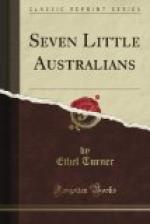Under the front buggy seat where Mr. Hassal sat was a box containing a beautiful gown, all daffodil silk and delicate wavelets of chiffon. And there were daffodil shoes and stockings, a plume fan in a hat-box on her knee, and a lovely trained white underskirt with billowy frills of torchon, the very sight of which made Meg wild to be grown up.
But none of these things were to be donned for many an hour yet.
The ball was a neat little matter of fifty-five miles away, across country, so she had to start tolerably early, of course, in order to have comfortable time to “titivate,” as Pip expressed it.
The children, as compensation for having no part in this pleasure, were to have a very, out-of-the-way kind of picnic all to themselves.
In the first place, the picnic ground was fourteen miles away; in the second, the journey was to be made, not in everyday buggies, or on commonplace horses, but on a dray drawn by a team of twelve yoked bullocks.
A boundary-rider had reported that a magnificent blue gum that they had long called King Koree had been blown down during a violent gale, and Mr. Hassal immediately declared that, whatever the trouble, it must be brought for the foundation of a kind of dam across the creek at Krangi-Bahtoo, the picnic spot. The fallen bush monarch lay twenty miles away from the station, and six beyond the place chosen for the picnic; so it was arranged the trolly should carry the party for the fourteen miles, leave them to picnic, go forward for the tree, bring it back, and deposit it near the creek ready for future operations, and bring the children back in the cool of the evening.
But for escorting his daughter to the ball, Mr. Hassal would have gone himself to the place and seen about it in person. As it was, he placed the great trolly in the charge of four men, with instructions to pick up a couple of men from distant huts to help in the task.
Krangi-Bahtoo—or Duck Water, as, less prettily, we should call it—was the name given to the head of the creek, which had scooped out the earth till it made itself a beautiful ravine just there, with precipitous rocks and boulders that the kangaroos skipped across and played hide-and-seek behind with hunters, and great towering blue gums and red gums, that seemed to lose themselves in the blue, blue sky-canopy above.
Tettawonga told of a Bunyip that dwelt where the trickling water had made a pool, deep and beautiful, and delicate ferns had crept tenderly to fringe its edge, and blackwood, and ti-trees grown up thick and strong for a girdle. The water-hen made a home there, the black swan built among the grass-like reeds, the wild duck made frequent dark zigzag lines against the sky. From the trees the bell-bird, the coach-whip, the tewinga, the laughing-jackass, the rifle-bird and regent, filled the air with sound, if not with music. And the black snake, the brown snake, the whip, the diamond, and the death adder glided gently among the fallen leaves and grasses, and held themselves in cheerful readiness for intruders. That was why a condition was attached to the freely granted picnic.




